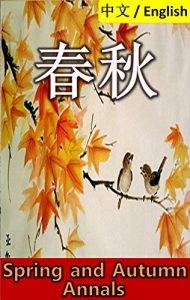Spring and Autumn Annals is an ancient Chinese chronicle that has been one of the core Chinese classics since ancient times. This edition of Spring and Autumn Annals features both English and Chinese side-by-side for easy reference and bilingual support. The paragraphs are linked and organized for easy reading. The bilingual study edition includes the commentary of Zuo for each chapter, and also a Classical Chinese Study Guide.
The Annals is the official chronicle of the State of Lu, and covers a 241-year period from 722 to 481 BC. It is the earliest surviving Chinese historical text to be arranged in annals form. Because it was traditionally regarded as having been compiled by Confucius (after a claim to this effect by Mencius), it was included as one of the Five Classics of Chinese literature 五经.
The Annals records main events that occurred in Lu during each year, such as the accessions, marriages, deaths, and funerals of rulers, battles fought, sacrificial rituals observed, celestial phenomena considered ritually important, and natural disasters. The entries are tersely written, averaging only 10 characters per entry, and contain no elaboration on events or recording of speeches.
During the Warring States period, a number of commentaries to the Annals were created that attempted to elaborate on or find deeper meaning in the brief entries in the Annals. The Commentary of Zuo, the best known of these commentaries, became a classic in its own right, and is the source of more Chinese sayings and idioms than any other classical work.
《春秋》本指先秦時代各國的編年體史書,但后世不传。传之唯魯國《春秋》。此书记载了从鲁隐公元年(前722年)到鲁哀公十四年(前481年)的历史,也是中国现存最早的编年体史书。《春秋》一书,宛若新闻标题,意不在史而在“义”。辜鸿铭之《中國人的精神》,所承于此。
虽然据《宋史》记载王安石对此书的评价为“斷爛朝報”,但《宋史》的作者对其变法和学术多做负面评价,自北宋以来,为王安石辩护者众。通览王安石全部著作,无一语诋《春秋》者,反而多次引用《春秋》传义[4]。
在四庫全書之中為經部(為十三經之一)。
这本有英文和中文在一起。
The Annals is the official chronicle of the State of Lu, and covers a 241-year period from 722 to 481 BC. It is the earliest surviving Chinese historical text to be arranged in annals form. Because it was traditionally regarded as having been compiled by Confucius (after a claim to this effect by Mencius), it was included as one of the Five Classics of Chinese literature 五经.
The Annals records main events that occurred in Lu during each year, such as the accessions, marriages, deaths, and funerals of rulers, battles fought, sacrificial rituals observed, celestial phenomena considered ritually important, and natural disasters. The entries are tersely written, averaging only 10 characters per entry, and contain no elaboration on events or recording of speeches.
During the Warring States period, a number of commentaries to the Annals were created that attempted to elaborate on or find deeper meaning in the brief entries in the Annals. The Commentary of Zuo, the best known of these commentaries, became a classic in its own right, and is the source of more Chinese sayings and idioms than any other classical work.
《春秋》本指先秦時代各國的編年體史書,但后世不传。传之唯魯國《春秋》。此书记载了从鲁隐公元年(前722年)到鲁哀公十四年(前481年)的历史,也是中国现存最早的编年体史书。《春秋》一书,宛若新闻标题,意不在史而在“义”。辜鸿铭之《中國人的精神》,所承于此。
虽然据《宋史》记载王安石对此书的评价为“斷爛朝報”,但《宋史》的作者对其变法和学术多做负面评价,自北宋以来,为王安石辩护者众。通览王安石全部著作,无一语诋《春秋》者,反而多次引用《春秋》传义[4]。
在四庫全書之中為經部(為十三經之一)。
这本有英文和中文在一起。






